QuestionQUESTION: I just ordered 3 baby Sulcata tortoises from Tortoise Supply. They are about 2 inches in length. I keep them in a 40 gallon tank with cypress mulch as bedding. During daylight hours there is a 100 degree basking spot and, not only are they in the sunniest room of they house, they also have a UV lamp. I have used a plastic container to create a burrow for them that usually is at about 90% humidity. My tortoises do not have a water dish, however I do soak them in shallow 80-85 degree water for half an hour every other day. currently I feed my tortoises about 6 times a week. They are fed a lightly packed 1/4 cup of spring mix mixed with either a small palm full of grass or a few moistened pellets of Zoo Med grassland tortoise food once a day. The spring mix is sometimes substituted by kale or broccoli. I dust all of their food with Rep-cal calcium supplement. I have had my baby tortoises for about 3 weeks.
Two of my baby tortoises are always very active, eat a lot, and get rid of waste frequently. The smallest of my tortoises doesn't eat as much as the others, isn't quite as active, and gets rid of waste less frequently. When I put food in the tank two of my tortoises rush to it, but the smallest one waited a few hours before even touching his food. The smallest tortoise sleeps often and appears to be always swallowing or breathing in a "gulping" manner. But he never opens his mouth when breathing. Sometimes in the mornings, he doesn't become active, or open both eyes, until I soak him or he is left for a long period of time. He sometimes acts as if it's hard to open his eyes. He has full control of his limbs and his shell doesn't appear to be soft or squishy. A little time each day he acts like a normal baby tortoise walking around his cage and eating. Most of the time he is sleeping and breathing strangely. What's wrong with my tortoise?
Before I go any farther, I will tell you that I am well aware of the commitment with owning Sulcata tortoises. I know that they can grow very very large and live for MANY years. I am perfectly capable of providing the care and space these tortoises need. I have thought very hard about owning Sulcatas and they were not an impulse buy. Thank you so much for your time.
Sincerely,
Jenny
ANSWER: Hi Jenny,
First of all, get them out of the tank. A 40 gallon tank is much too small for three hatchlings of any species, and they don't do well in tanks anyway. Because sulcata grow quickly and require plenty of room even as hatchlings and juveniles, I would go to the effort of building a large tortoise table (the size of a sheet of plywood) now, so that it will work for you for a few years before you have to start thinking about larger accommodations. I assume you know that at some point you will need either a heated outdoor shed, or a large basement area to house them during the winter and at night in the warmer months (with room to separate in case you end up with two aggressive males, or worse, two males and a female), but for now a tortoise table will do. The more room you can provide, even when they're a smaller size, the healthier they will be, because tortoises require plenty of room for exercise.
Take out the cypress mulch and replace it with a 50/50 mix of coir and playsand. Keep at least the basking area slightly damp. Dehydration is a very real issue with hatchling tortoises, and heat lamps are very drying. A humid hide is fine, but you also want humidity in the substrate, and also provide a shallow water dish big enough for them to get into at all times. You need a basking temp of 90-95. 100 degrees is too hot, and will increase the risk of dehydration. Make sure the UVB (not UV or UVA) bulb you're using is a good one. You can look at the list here: http://russiantortoise.org/uvb.htm. UVB doesn't penetrate window glass, so natural sunlight coming through a window doesn't make any difference.
You need to offer more variety in the diet. Spring mix is fine as part of the diet, but it's heavy on lettuce and young greens; you also want to mix in other greens, grasses, and hay. Turnip, mustard, kale, collards, dandelion are all good, along with weeds such as chicory, chickweed, clover, sow thistle, plantain, hawkbit, etc.; hibiscus and abutilon flowers, nasturtium, viola, rose petals, grape and mulberry leaves, etc. Prickly pear cactus is also good. Avoid any vegetables or fruit, as well as commercial foods. A varied natural diet is best for them. Put a cuttlebone in the enclosure rather than dusting the food with calcium to avoid over-supplementing them.
You may simply need to tweak your enclosure a bit (get them out of the tank, change the substrate and dampen it, improve the UVB and diet, etc.) to perk up the lethargic tortoise. However, buying from a large-scale breeder/dealer can have its drawbacks, and one is that the hatchlings don't get the kind of individual attention they would from a small hobby breeder. A small breeder knows every hatchling and whether one is ready to ship or not. When you're producing hundreds of hatchlings, it's not always so easy. Another issue is the condition of the female breeders--healthy breeders produce healthy offspring. I can't speak to the reputation of where you got your tortoises, but I can say that I've seen an alarming number of unhealthy hatchlings come from large breeders/dealers and because of this I recommend that people only buy hatchlings from small hobby breeders recommended to them by someone they trust. Sulcata I don't recommend buying at all because there's so many in rescue already. I know you said you're aware of their requirements and are willing to provide for them, which is great, but many people who get sulcata find reality overwhelming and that's why rescues are overflowing with them. A 100-200 lb. tortoise that poops and pees like a small pony is more than most people bargain for.
If your lethargic tortoise doesn't come around with some adjustments to the habitat, I would bring it in to a good vet experienced with tortoises for an exam and a fecal check.
---------- FOLLOW-UP ----------
QUESTION: I know it's important to keep baby tortoises in high humidity even though adult tortoises need to be kept in dry climates. I am wondering at what age should I change my tortoises from living in a humid enclosure to a dry one? I have heard that to much humidity can cause respiratory problems with adult tortoises. For as long as they need humidity I will keep them in a tortoise table with damp substrate and when they are big enough, and don't need humidity, I will move them into my backyard. I live in a very dry, nearly desert, area. Thanks!!!
P.S. Thanks to your advice, my baby tortoise is back to normal!
AnswerHi Jenny,
I'm really glad to hear your tortoise is doing better. That's great!
It's really untrue that adult arid habitat tortoises should be kept dry. The reason is that desert species actually spend much of their time conserving water, because to lose water is to die. When it's very hot, they spend most of their time in long underground burrows where the humidity is significantly higher than on the surface (approximately 70%). They come out to forage in the morning, retreat to their burrows for most of the day, and then come out again in the early evening. They also don't release urine unless they have a way to replenish that moisture, which is one reason why you'll often see them urinate while drinking (or eating wetter foods).
The basking lamp duplicates the desert sun, but indoors at least, the ability to create long burrows is limited. So as long as your tortoises are inside, they should have a dampened substrate. Outdoors, they should be given the chance to burrow or artificial burrows created for them. One problem with very large sulcatas is that they can dig burrows that are up to 20 feet long, so it's worth the effort to try to train them to accept artificial burrows or houses. There should be access to water, and if it's hot and dry, watering down the enclosure and providing mud wallows is a good idea.
Humidity will not cause respiratory problems unless it's cold and wet. Warm and humid is not a problem. I know many people who have successfully kept "dry" species for years outdoors in the South without problems, and I have tortoises that do just fine in the foggy summers here (they do have dry shelters). Lack of moisture (dehydration) is much more likely to cause serious health problems, so don't worry about it.

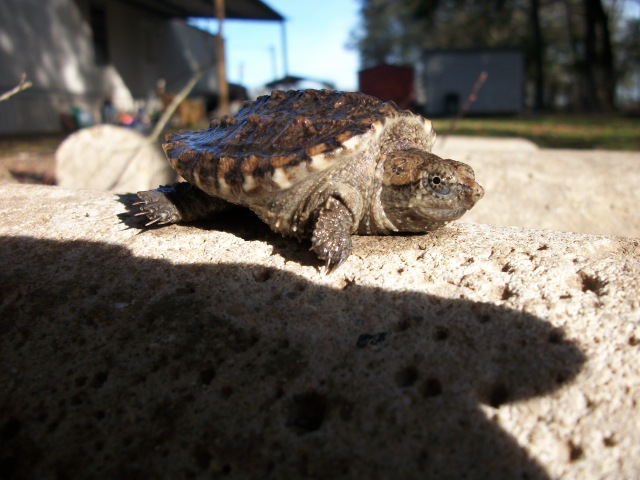 Species identification?
QuestionSnapping Turtle
QUESTION: Can you tell m
Species identification?
QuestionSnapping Turtle
QUESTION: Can you tell m
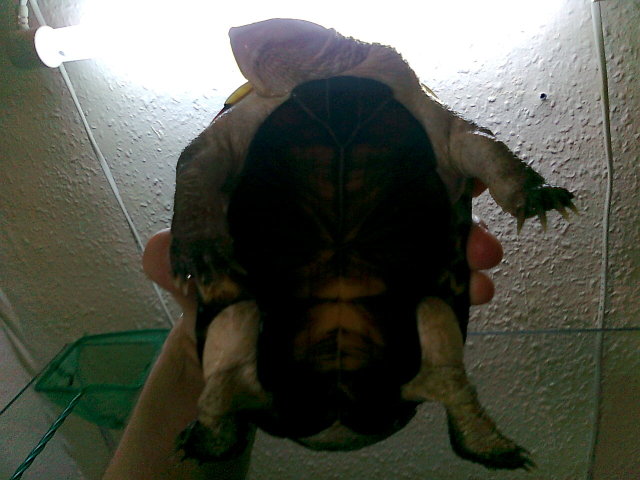 African helmeted with swollen body
QuestionShowing swelling
QUESTION: Hi there,
I h
African helmeted with swollen body
QuestionShowing swelling
QUESTION: Hi there,
I h
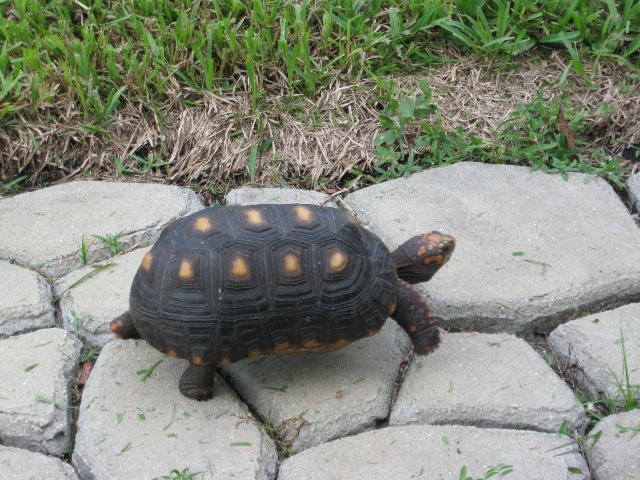 What kind of turtle?
Question
Turtle 1
I was mowing the lawn on Friday and
What kind of turtle?
Question
Turtle 1
I was mowing the lawn on Friday and
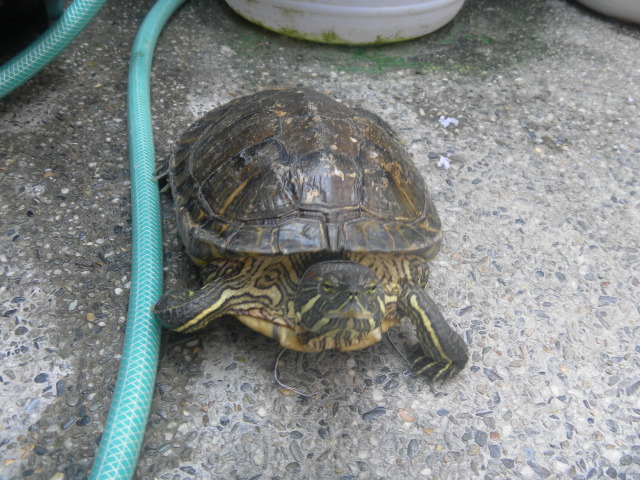 is she healthy?
Questionmy cute turtle
QUESTION: Hi Tina! I forg
is she healthy?
Questionmy cute turtle
QUESTION: Hi Tina! I forg
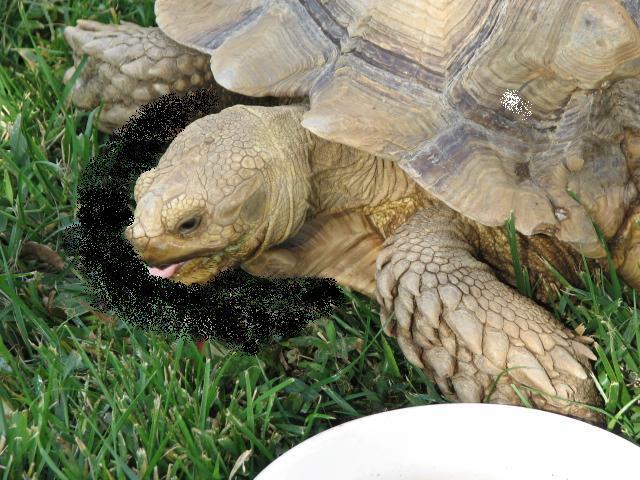 African Succata has Acrylic Paint on back
Question
Tim
Please help! Acrylic Paint on Tim the Turt
African Succata has Acrylic Paint on back
Question
Tim
Please help! Acrylic Paint on Tim the Turt